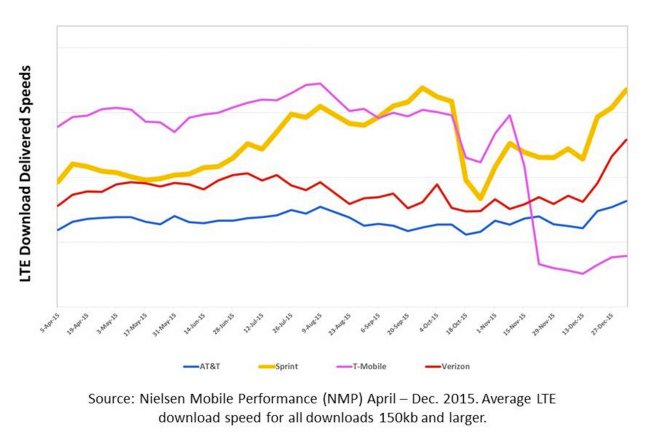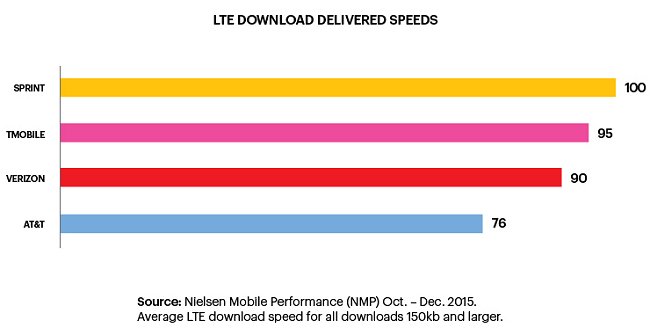Last week, Sprint issued a press release touting results of a Nielsen study that found on average, that the Sprint network provided faster download speeds than T-Mobile, Verizon, and AT&T.
One of the comparison charts they included was this:

While this chart shows the relative comparison between the cell brands, something important is missing.
*MOUSE PRINT:
The label on the Y-axis (going up the left and right sides) is missing or has been deliberately stripped off. (Remember your high school math teacher warning you to be leery of graphs that didn’t start at zero?)
If the figures on the Y-axis were shown, it would disclose what the actual average download speed was for each of the cellular networks — an important fact for consumers to be aware of. Is Sprint providing average speeds of 50 Mbps (really fast) or only 5 Mbps (really slow)? And what about the other companies and how do those speeds compare to home Internet speeds?
So, we asked Sprint to provide the speeds for each company, but they declined.
“We are not providing speed scale for the other chart per Nielsen’s request that we not share this data.” — Sprint Corporate Communications
They did provide a second chart showing the relative difference between the four carriers.

In this one, Sprint and T-Mobile are shown to be only five percent apart. The first chart above, however, makes the difference appear much more extreme.
Hmmm. What’s going on here? Was it really Nielsen that didn’t want this information disclosed, or was it Sprint? (If, for example, Sprint promised a particular download speed to customers, and this study of 70 million downloads proved they weren’t meeting the advertised speed, that could spell a big problem for them or the other companies if they made similar promises.)
So… we asked Nielsen to provide the missing average speeds that they found for each carrier. And despite repeated requests, they would not provide the information nor provide an on-the-record reason why. Why are they hiding this information? We may never know.
To at least put some of the results in context, in the early months of the study, T-Mobile commanded the top spot for fastest downloads in the Nielsen study. It is probably not coincidental that their drop to last place began when, in November, the company introduced unlimited free downloading of video services like Netflix, Hulu, and HBO.

There’s no way that Sprint would want to share numbers for absolute data speeds being delivered. That would provide consumers with actual data rather than just marketing.
Shame on Nielsen for not being transparent. Did Sprint buy their silence? How can we trust them when they won’t answer?
In Nielsen’s defense, they don’t care if we trust them. We’re not making them any money. What matters is that the companies who pay Nielsen for data trust them.
From the first graph, you will see the ATT and VZ speeds are fairly consistent, T-Mo and Sprint seem to be all over the place.
Again, what are the real numbers? If you were to use the second graphs numbers as speeds, with Sprint at 100 to mean maybe 10mb/s, then ATT isn’t that far behind with about 7.5mb. If you are viewing a video, that difference probably won’t be noticed.
I like consistency.
@Alan: You’re right, Nielsen doesn’t care about the consumer. They live because of their past reputation for TV ratings. That is how most people even know about them.
OpenSignal’s report using data from the exact same time period seem to show another story.
http://opensignal.com/reports/2016/02/usa/state-of-the-mobile-network/